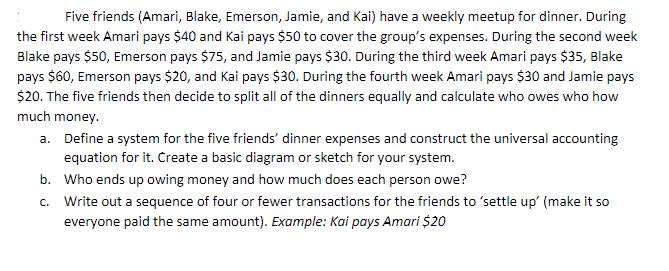Answered step by step
Verified Expert Solution
Question
1 Approved Answer
Five friends (Amari, Blake, Emerson, Jamie, and Kai) have a weekly meetup for dinner. During the first week Amari pays $40 and Kai pays

Five friends (Amari, Blake, Emerson, Jamie, and Kai) have a weekly meetup for dinner. During the first week Amari pays $40 and Kai pays $50 to cover the group's expenses. During the second week Blake pays $50, Emerson pays $75, and Jamie pays $30. During the third week Amari pays $35, Blake pays $60, Emerson pays $20, and Kai pays $30. During the fourth week Amari pays $30 and Jamie pays $20. The five friends then decide to split all of the dinners equally and calculate who owes who how much money. a. Define a system for the five friends' dinner expenses and construct the universal accounting equation for it. Create a basic diagram or sketch for your system. b. Who ends up owing money and how much does each person owe? c. Write out a sequence of four or fewer transactions for the friends to 'settle up' (make it so everyone paid the same amount). Example: Kai pays Amari $20
Step by Step Solution
★★★★★
3.50 Rating (170 Votes )
There are 3 Steps involved in it
Step: 1
a A possible system for the five friends dinner expenses is to treat each friend as an individual ac...
Get Instant Access to Expert-Tailored Solutions
See step-by-step solutions with expert insights and AI powered tools for academic success
Step: 2

Step: 3

Ace Your Homework with AI
Get the answers you need in no time with our AI-driven, step-by-step assistance
Get Started


